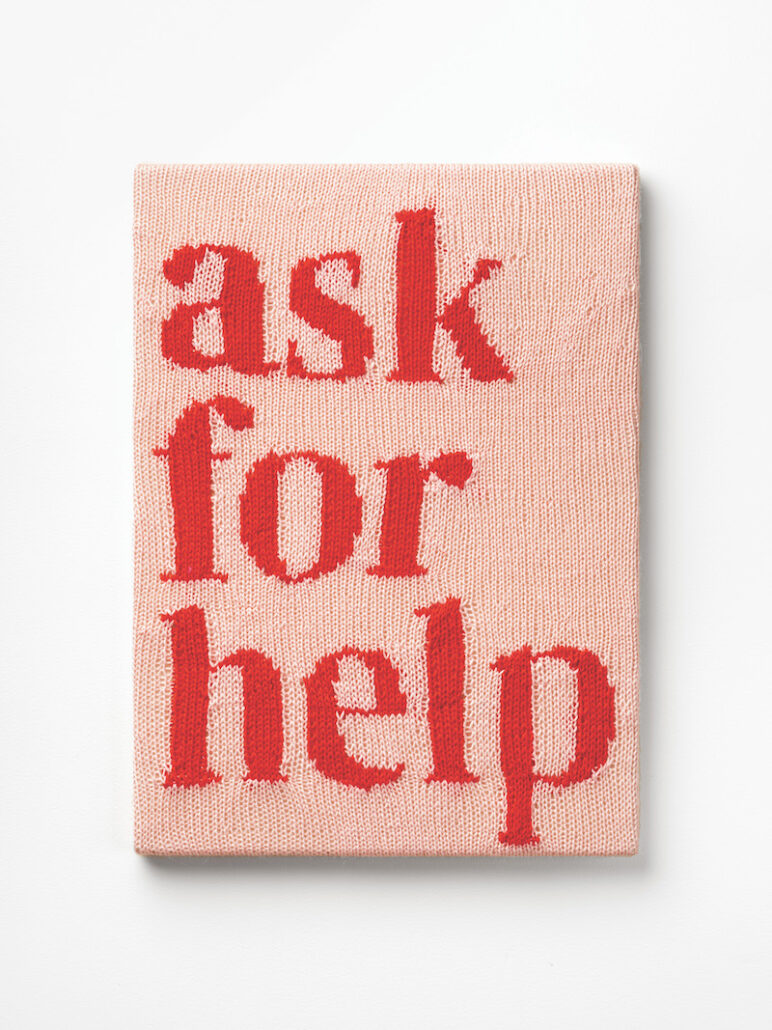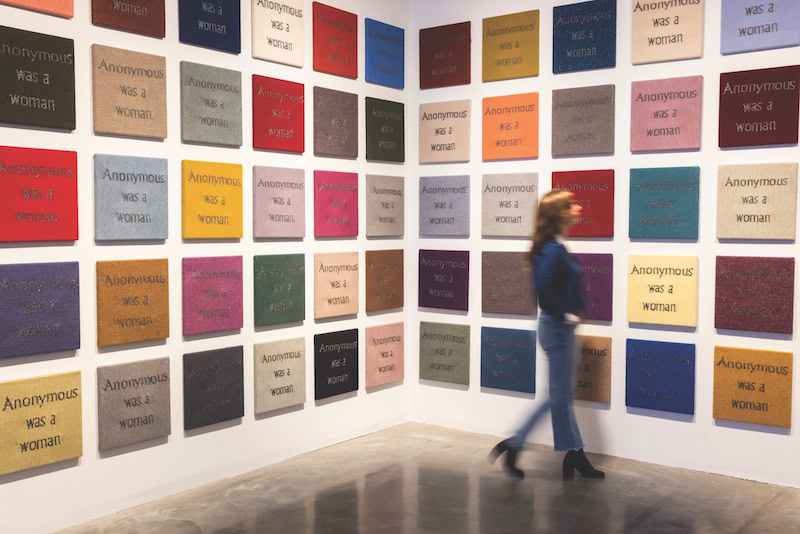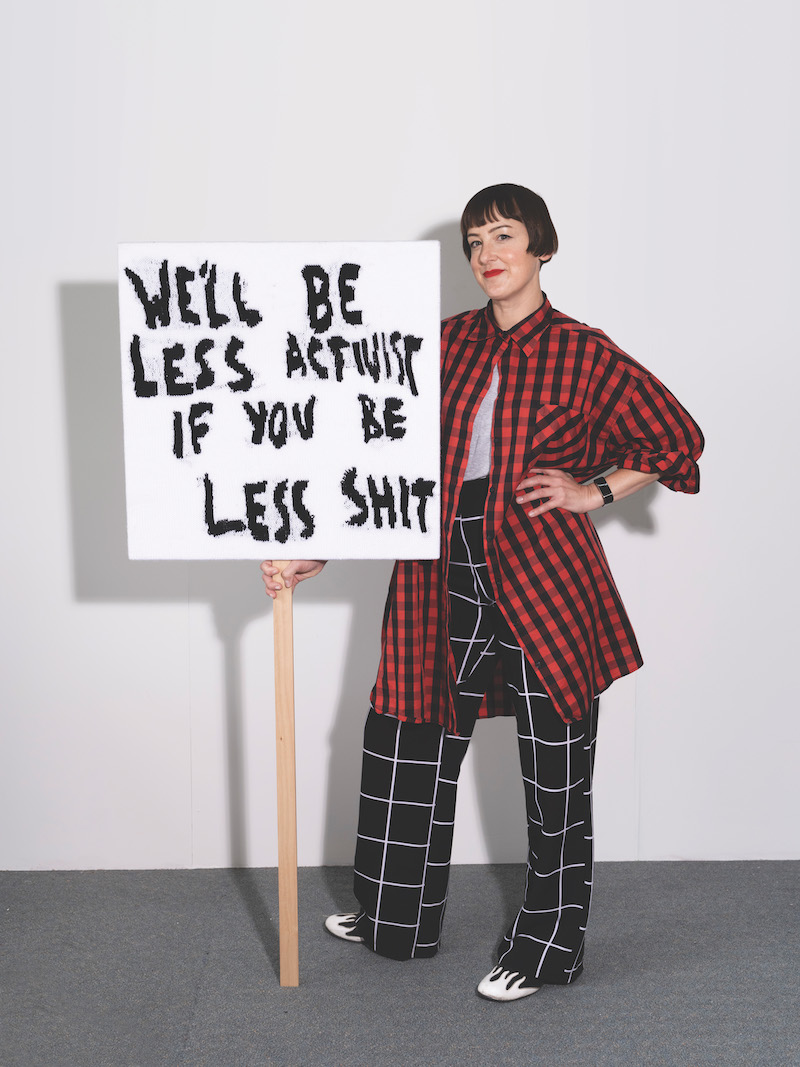If you can knit it, Kate Just probably has. This queer, feminist artist is obsessed with the centuriesold practice, employing it to create sculptures, pictures, text works and clothing that explore important social and political issues, as well as her own lived experience.
The two are inherently interconnected. Knitting and other so-called “craft” practices like textiles and sewing have had a long historical association with “women’s work”, and the domestic spaces, activities and experiences often excluded from the art canon.
“Because of this, knitting and other textile practices have become a personal or alternative record to the canon of painting that reveals important personal, social, and political shifts over time,” says Just. “From protest banners for Civil Rights, to the AIDS Quilts, to craftivist projects for climate change or peace, to my own feminist crafted artworks, craft advances feminism and social change. My work explores these intersections between craft, fashion, performance, and social justice, and tells the story of my own life as a queer woman.”
In this way, Just considers her work, and the work of her crafty contemporaries, as a political act. “All of my work engages with a feminist desire to transform suppressive histories, reclaim subjective agency, and reshape gendered representation in art and culture,” she says. “My reclamation of textiles and craft materials to question and reimagine historic representations of gender is a social, personal and politically motivated process and practice.”
But it is also deeply personal and often autobiographical. Just began knitting in the year 2000 after the tragic loss of her brother. “In a moment of grief, my mother sat beside me and taught me to knit,” she says. “In that moment, I understood knitting to be a powerful personal tool for narrating stories and creating new bonds.”
As her practice has developed, her knitted works have become more elaborate. Projects have included knitted family trees and effigies; knitted skins and armours (expressions of female embodiment that formed her practice-led PhD); knitted replicas of famous works by feminist artists; 140 panels bearing the text “Anonymous Was A Woman” knitted in a two-year-long performance; and knitted pictures of protesters with signs, replicas of images sourced from news and social media, family and friends.
Her 2022-2023 work Self Care Action Series, staged at Linden New Art in Melbourne, arose from the artist’s lived experiences as a queer feminist, artist, teacher, advocate, activist and parent. The handknitted panels bearing self-care prompts (“ask for help”, “create a safe home base”, “have good sex”) explored the “radical roots of self-care” and provided insightful, self-referential and at times humorous advice to sustain ourselves in tough times. Just also often works in collaboration with communities to create large scale, public art projects that tackle important social issues like sexual harassment and gendered violence.
It’s little surprise such a rigorous and considered practice has garnered plenty of critical and collector attention. Just has been the recipient of more than 40 grants, prizes, fellowships and residencies in her career to date. For more than two decades, she has consistently exhibited in major intuitions and galleries across Australia and further aboard. Commercially, Just is represented by Hugo Michell Gallery in Adelaide.
/ In a moment of grief, my mother sat beside me and taught me to knit. In that moment, I understood knitting to be a powerful personal tool for narrating stories and creating new bonds. / KATE JUST
Her forthcoming show at Hugo Michell is called 50 Rules for Making Art and includes 50 hand-knitted, brightly coloured, square panels of text. Each Post-itstyle note bears a rule or lesson the artist has learned about the artmaking process: “Learn to Live with Financial Insecurity”, “Get Used to Rejection”, “Take Risks”, and “Have a Family if You Want to”, to name a few. “This show will open in the month of my 50th birthday, so I used my number of years alive to decide on the number of rules,” says Just. “As I hand-knitted works in this show, I reflected on my life as an artist, what I have learned and what might come next.”
Just hopes the show will encourage audiences to reflect on how much time, energy and risk goes into making art, and to feel inspired by how much artists give to their work, and in turn the world. “I hope it helps younger artists to recognise that though a life as an artist is hard, it is also rewarding, and worth doing.”
2024 also sees the artist undertake new work that responds to images in the Australian Queer Archives. A residency at Bundanon in New South Wales later in the year will afford her sustained time to develop that project. She’ll also continue her work with Regional Assembly, an online gathering of local and international artists working regionally and remotely. Travel is also on the cards, as well as attending events with the 5th Tamworth Textile Triennial, currently on its national tour.
And of course, there will be knitting. “In every project and with every stitch, I consider how far feminism has come,” Just concludes. “And how far we still have to go.”
Above: Artist Kate Just holding her knitted art work We’ll be less activist if you be less shit. Hand knitted wool and acrylic yarns, timber. Photo: Simon Strong. Courtesy: the artist and Hugo Michell Gallery.





